Interannual to Interdecadal Variability of the Southern Yellow Sea Cold Water Mass and Establishment of “Forcing Mechanism Bridge”
Abstract
:1. Introduction
2. Materials and Methods
2.1. Study Area
2.2. CORA Data
2.3. Climate and Intensity Indices
2.4. Methods
3. Results
3.1. Interannual Variability of the SYSCWM
3.1.1. Local Forcings
3.1.2. Effect of ENSO
3.2. Decadal Variability of SYSCWM
3.2.1. Local or Intermediate Forcings
3.2.2. Remote Forcings
4. Discussion
5. Conclusions
Author Contributions
Funding
Institutional Review Board Statement
Informed Consent Statement
Data Availability Statement
Acknowledgments
Conflicts of Interest
References
- He, C.B.; Wang, Y.X.; Lei, Z.Y.; Xu, S. A preliminary study of the formation of Yellow Sea cold mass and its properties. Oceanol. Limnol. Sin. 1959, 2, 11–15. (In Chinese) [Google Scholar]
- Chen, Y.L.; Hu, D.X.; Wang, F. Long-term variabilities of thermodynamic structure of the East China Sea Cold Eddy in Summer. J. Oceanol. Limnol. 2004, 22, 224–230. [Google Scholar] [CrossRef]
- Lie, H.-J.; Cho, C.-H.; Lee, J.-H.; Lee, S.; Tang, Y.; Zou, E. Does the yellow sea warm current really exist as a persistent mean flow? J. Geophys. Res. Oceans 2001, 106, 22199–22210. [Google Scholar] [CrossRef]
- Hur, H.B.; Jacobs, G.A.; Teague, W.J. Monthly variations of water masses in the Yellow and East China Seas, November 6, 1998. J. Oceanogr. 1999, 55, 171–184. [Google Scholar] [CrossRef]
- Horsburgh, K.J.; Hill, A.E.; Brown, J.; Fernand, L.; Garvine, R.W.; Angelico, M.M.P. Seasonal evolution of the cold pool gyre in the western Irish Sea. Prog. Oceanogr. 2000, 46, 1–58. [Google Scholar] [CrossRef]
- Yu, X.; Guo, X.; Takeoka, H. Fortnightly variation in the bottom thermal front and associated circulation in a semienclosed sea. J. Phys. Oceanogr. 2016, 46, 159–177. [Google Scholar] [CrossRef]
- Li, H.B.; Xiao, T.; Ding, T.; Lu, R. Effect of the Yellow Sea Cold Water Mass (YSCWM) on distribution of bacterioplankton. Acta Ecol. Sin. 2006, 26, 1012–1019. [Google Scholar] [CrossRef]
- Wang, D.; Huang, B.Q.; Liu, X.; Lu, G.; Wang, H. Seasonal variations of phytoplankton phosphorus stress in the Yellow Sea Cold Water Mass. Acta Oceanol. Sin. 2014, 33, 124–135. [Google Scholar] [CrossRef]
- Liu, X.; Huang, B.Q.; Huang, Q.; Wang, L.; Ni, X.; Tang, Q.; Song, S.; Hao, W.; Liu, S.; Li, C.; et al. Seasonal phytoplankton response to physical processes in the southern Yellow Sea. J. Sea Res. 2015, 95, 45–55. [Google Scholar] [CrossRef]
- Xin, M.; Ma, D.Y.; Wang, B.D. Chemicohydrographic characteristics of the Yellow Sea Cold Water Mass. Acta Oceanol. Sin. 2015, 34, 5–11. [Google Scholar] [CrossRef]
- Wang, B.; Hirose, N.; Kang, B.; Takayama, K. Seasonal migration of the Yellow Sea Bottom Cold Water. J. Geophys. Res. Oceans 2015, 119, 4430–4443. [Google Scholar] [CrossRef]
- Wang, R.; Zuo, T.; Wang, K. The Yellow Sea cold bottom water-an oversummering site for Calanus sinicus (Copepoda, Crustacea). J. Plankton Res. 2003, 25, 169–183. [Google Scholar] [CrossRef] [Green Version]
- Cho, K.D. On the influence of the Yellow Sea Bottom Cold Water on the demersal fishing grounds. J. Korean Soc. Fish. Technol. 1982, 18, 25–33. [Google Scholar]
- Du, B.; Zhang, Y.J.; Shan, Y.C. The characteristics of cold water mass variation at the bottom of the North Yellow Sea and its hydrological effects on the mortality of shellfish cultured in the waters of outer Changshun Islands. Mar. Sci. Bull. 1996, 15, 17–28, (In Chinese with English abstract). [Google Scholar]
- Wan, B.J.; Guo, B.H.; Chen, Z.S. A three-layer model for the thermal structure in the Huanghai Sea. Acta Oceanol. Sin. 1990, 9, 159–172. [Google Scholar]
- Miu, J.B.; Liu, X.Q.; Xue, Y. The preliminary discussion of the formation mechanism of the north Yellow Sea Cold Water Mass-II. Discussion of model solution. Sci. China 1991, 21, 74–81. (In Chinese) [Google Scholar] [CrossRef]
- Chu, P.C.; Wells, S.K.; Haeger, S.D.; Szczechowski, C.; Carron, M. Temporal and spatial scales of the Yellow Sea thermal variability. J. Geophys. Res. Oceans 1997, 102, 5655–5667. [Google Scholar] [CrossRef] [Green Version]
- Hu, D.X.; Wang, Q.Y. Interannual variability of the southern Yellow Sea cold water mass. Chin. J. Oceanol. Limnol. 2004, 22, 231–236. [Google Scholar] [CrossRef]
- Yu, F.; Zhang, Z.X.; Diao, X.Y. Analysis of evolution of the Huanghai Sea Cold Water Mass and its relationship with adjacent water masses. Acta Oceanol. Sin. 2006, 28, 26–34, (In Chinese with English abstract). [Google Scholar]
- Zhang, S.W.; Wang, Q.Y.; Lu, Y.; Cui, H.; Yuan, Y.L. Observation of the seasonal evolution of the Yellow Sea Cold Water Mass in 1996–1998. Cont. Shelf Res. 2008, 28, 442–457. [Google Scholar] [CrossRef]
- Park, S.; Chu, P.C.; Lee, J.H. Interannual-to-interdecadal variability of the Yellow Sea Cold Water Mass in 1967–2008: Characteristics and seasonal forcings. J. Mar. Syst. 2011, 87, 177–193. [Google Scholar] [CrossRef] [Green Version]
- Yuan, Y.L.; Li, H.Q. Theoretical study on the circulation structure and the formation mechanisms related to cold water mass of Yellow Sea- I. The zero order solution and circulation structure of cold water mass. Sci. China 1993, 23, 93–103. (In Chinese) [Google Scholar]
- Ren, H.J.; Zhan, J.M. A numerical study on the seasonal variability of the Yellow Sea cold water mass and the related dynamics. J. Hydrodyn. 2005, 20 (Suppl. 1), 887–896. [Google Scholar] [CrossRef]
- Jiang, B.J.; Bao, X.W.; Wu, D.X.; Xu, J.P. Interannual variation of temperature and salinity of northern Huanghai Sea Cold Water Mass and its probable cause. Acta Oceanol. Sin. 2007, 29, 1–10. [Google Scholar] [CrossRef]
- Wei, H.; Shi, J.; Lu, Y.Y.; Peng, Y. Interannual and long-term hydrographic changes in the Yellow Sea during 1977–1998. Deep-Sea Res. Part II Top. Stud. Oceanogr. 2010, 57, 1025–1034. [Google Scholar] [CrossRef]
- Yang, H.W.; Cho, Y.K.; Seo, G.H.; You, S.H.; Seo, J.W. Interannual variation of the southern limit in the Yellow Sea Bottom Cold Water and its causes. J. Mar. Syst. 2014, 139, 119–127. [Google Scholar] [CrossRef]
- Li, X.W.; Wang, X.D.; Chu, P.C.; Zhao, D. Low-frequency variability of the Yellow Sea Cold Water Mass identified from the China coastal waters and adjacent seas reanalysis. Adv. Meteorol. 2015, 2015, 269859. [Google Scholar] [CrossRef] [Green Version]
- Zhu, J.Y.; Shi, J.; Guo, X.Y.; Guo, H.; Yao, X. Air-sea heat flux control on the Yellow Sea Cold Water Mass intensity and implications for its prediction. Cont. Shelf Res. 2018, 152, 14–26. [Google Scholar] [CrossRef]
- Han, G.J.; Li, W.; Zhang, X.F.; Li, D.; He, Z.; Wang, X.; Wu, X.; Yu, T.; Ma, J. A regional ocean reanalysis system for coastal waters of China and adjacent seas. Adv. Atmos. Sci. 2011, 28, 682–690. [Google Scholar] [CrossRef]
- Wei, H.; Yuan, C.Y.; Lu, Y.Y.; Zhang, Z.; Luo, X. Forcing mechanisms of heat content variations in the Yellow Sea. J. Geophys. Res. Oceans 2013, 118, 4504–4513. [Google Scholar] [CrossRef]
- Zhang, Q.L.; Hou, Y.J.; Qi, Q.H.; Zheng, D.M.; Cheng, M.H. Variations in the Kuroshio heat transport in the East China Sea and meridional wind anomaly. Adv. Mar. Sci. 2008, 26, 126–134. (In Chinese) [Google Scholar]
- Sun, X.J.; Wang, P.X.; Zhi, H.; Guo, D. Analysis and comparison of several Mongolian High circulation indices and their relationship with temperature anomaly of China in winter. Plateau Meteorol. 2010, 29, 1493–1500. (In Chinese) [Google Scholar]
- Wang, P.X.; Wang, J.L.X.L.; Zhi, H.; Wang, Y.; Sun, Y. Circulation indices of the Aleutian Low pressure system: Definitions and relationships to climate anomalies in the northern hemisphere. Adv. Atmos. Sci. 2012, 29, 1111–1118. [Google Scholar] [CrossRef]
- Kalnay, E.; Kanamitsu, M.; Kistler, R.; Collins, W.; Deaven, D. The NCEP/NCAR 40-year reanalysis project. Bull. Amer. Meteorol. Soc. 1996, 77, 437–472. [Google Scholar] [CrossRef] [Green Version]
- McPhaden, M.J. TAO/TRITON tracks Pacific Ocean warming in early 2002. CLIVAR Exchanges 2002, 7, 7–9. [Google Scholar]
- Minobe, S.; Sako, A.; Nakamura, M. Interannual to interdecadal variability in the Japan Sea based on a new gridded upper water temperature dataset. J. Phys. Oceanogr. 2004, 34, 2382–2397. [Google Scholar] [CrossRef] [Green Version]
- Park, S.Y.; Chu, P.C. Interannual SST variability in the Japan/East Sea and relationship with environmental variables. J. Oceanogr. 2006, 62, 115–132. [Google Scholar] [CrossRef]
- Park, Y.H. Water characteristics and movements of the Yellow Sea Warm Current in summer. Prog. Oceanogr. 1986, 17, 243–254. [Google Scholar] [CrossRef]
- Isobe, A. The Taiwan–Tsushima Warm Current system: Its path and the transformation of the water mass in the East China Sea. J. Oceanogr. 1999, 55, 185–195. [Google Scholar] [CrossRef]
- Lie, H.-J.; Cho, C.-H.; Lee, J.-H.; Lee, S.; Tang, Y. Seasonal variation of the Cheju Warm Current in the northern East China Sea. J. Oceanogr. 2000, 56, 197–211. [Google Scholar] [CrossRef]
- Tang, Y.X.; Zou, E.M.; Lie, H.-J. On the origin and path of the Huanghai Warm Current during winter and early spring. Acta Oceanol. Sin. 2001, 23, 1–12, (In Chinese with English abstract). [Google Scholar]
- Yu, F.; Zhang, Z.X.; Diao, X.Y.; Guo, J. Erratum to: Observational evidence of the Yellow Sea warm current. J. Oceanol. Limnol. 2010, 28, 954. [Google Scholar] [CrossRef] [Green Version]
- Li, X.Y. A diagnostic study of 1998/2000 ENSO cold episode. J. Trop. Meteorol. 2001, 17, 90–96. [Google Scholar] [CrossRef]
- Kim, Y.S.; Kimura, R. Estimation of the heat flux exchanges between the air-sea interface over the neighbouring seas of Korean Peninsula. J. Atmos. Sci. 1999, 35, 501–510. [Google Scholar]
- Hsueh, Y.; Yuan, D.L. A numerical study of currents, heat advection, and sea-level fluctuations in the Yellow Sea in winter 1986. J. Phys. Oceanogr. 1997, 27, 2313–2326. [Google Scholar] [CrossRef]
- Moon, J.H.; Hirose, N.; Yoon, J.H. Comparison of wind and tidal contributions to seasonal circulation of the Yellow Sea. J. Geophys. Res. Oceans 2009, 114, C08016. [Google Scholar] [CrossRef]
- Ma, J.; Qiao, F.L.; Xia, C.S.; Kim, C.S. Effects of the Yellow Sea Warm Current on the winter temperature distribution in a numerical model. J. Geophys. Res. Oceans 2006, 111, C11S03. [Google Scholar] [CrossRef] [Green Version]
- Zhu, Y.M.; Yang, X.Q. Relationships between Pacific Decadal Oscillation (PDO) and climate variabilities in China. Acta Meteorol. Sin. 2003, 61, 641–654, (In Chinese with English abstract). [Google Scholar]
- Ding, Y.H.; Liu, Y.J.; Liang, S.J.; Ma, X.; Zhang, Y.; Liang, P.; Song, Y.; Zhang, J. Interdecadal variability of the East Asian winter monsoon and its possible links to global climate change. J. Meteorol. Res. 2014, 28, 693–713. [Google Scholar] [CrossRef]
- Qi, J.F.; Yin, B.S.; Yang, D.Z.; Xu, Z. The inter-annual and inter-decadal variability of the Kuroshio volume transport in the East China Sea. Oceanol. Et Limnol. Sin. 2014, 45, 1141–1147, (In Chinese with English abstract). [Google Scholar]
- Li, K.P. The response of the Yellow Sea Cold Water Mass on the ocean changes. Acta Oceanol. Sin. 1991, 13, 779–785. (In Chinese) [Google Scholar]
- Liu, J.P.; Guan, B.X. Preliminary study of relation between the Kuroshio Meander and the El Nino event. Acta Oceanol. Sin. 1986, 8, 123–129. [Google Scholar]
- Sun, X.P.; Wang, Y.P.; Yuan, Q.K.; Xuan, H. The variation of the Kuroshio during 1986–1988. Acta Oceanol. Sin. 1991, 10, 355–371. [Google Scholar]
- Josey, S.A. A comparison of ECMWF, NCEP–NCAR, and SOC surface heat fluxes with moored buoy measurements in the subduction region of the Northeast Atlantic. J. Clim. 2001, 14, 1780–1789. [Google Scholar] [CrossRef]
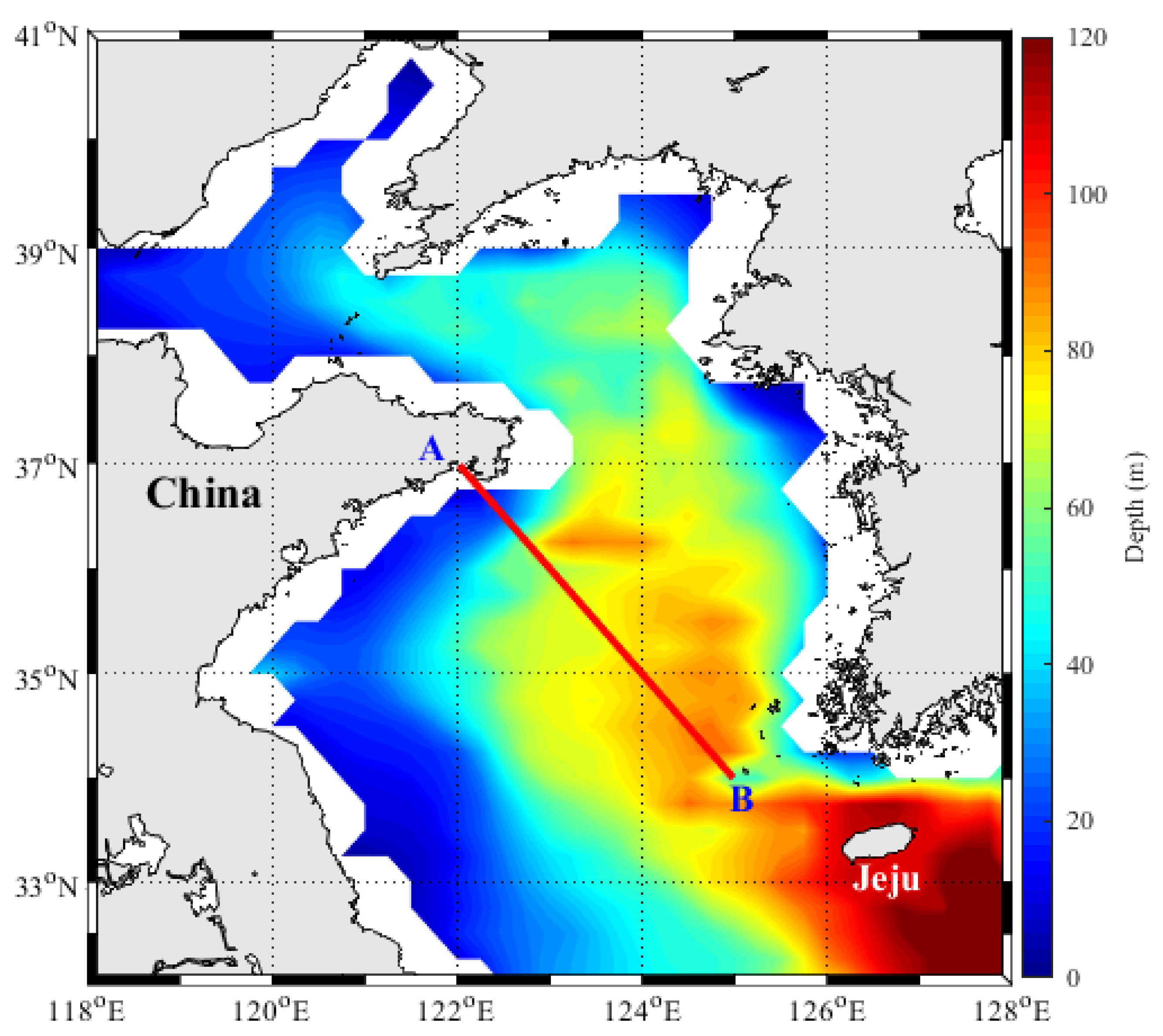
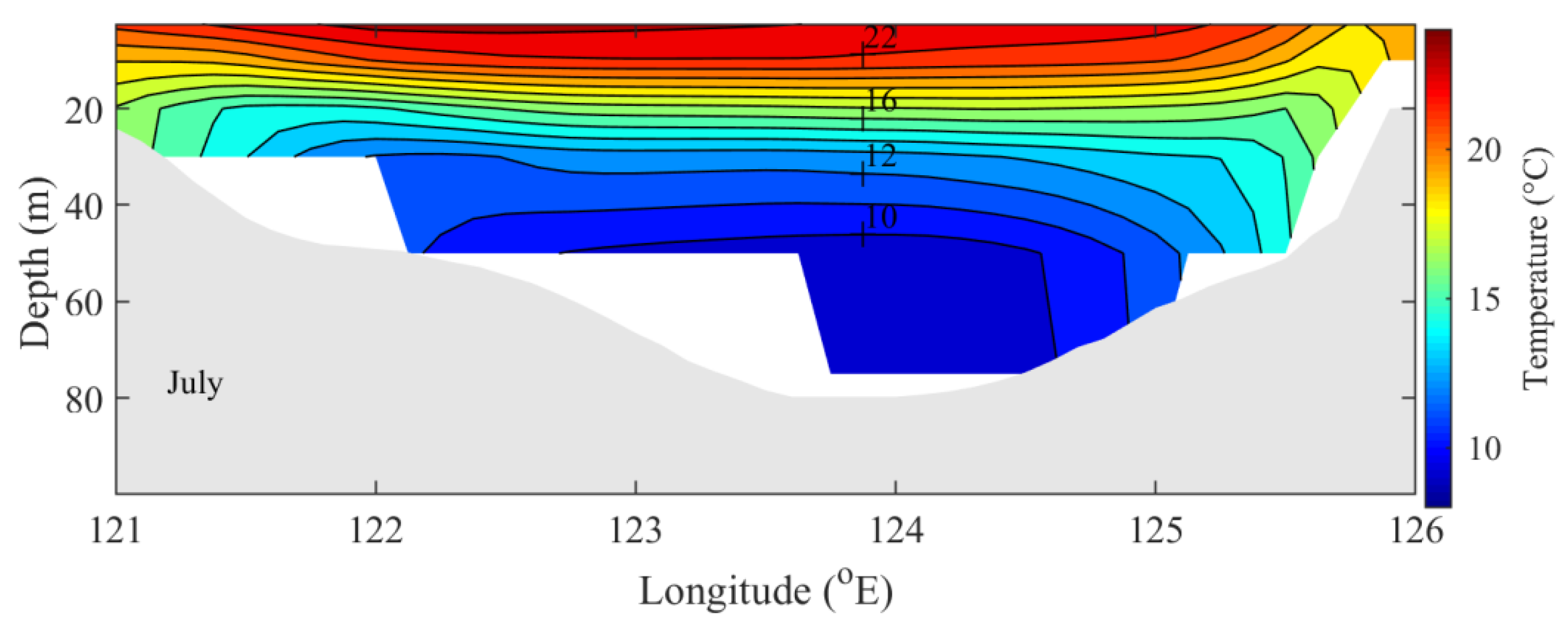
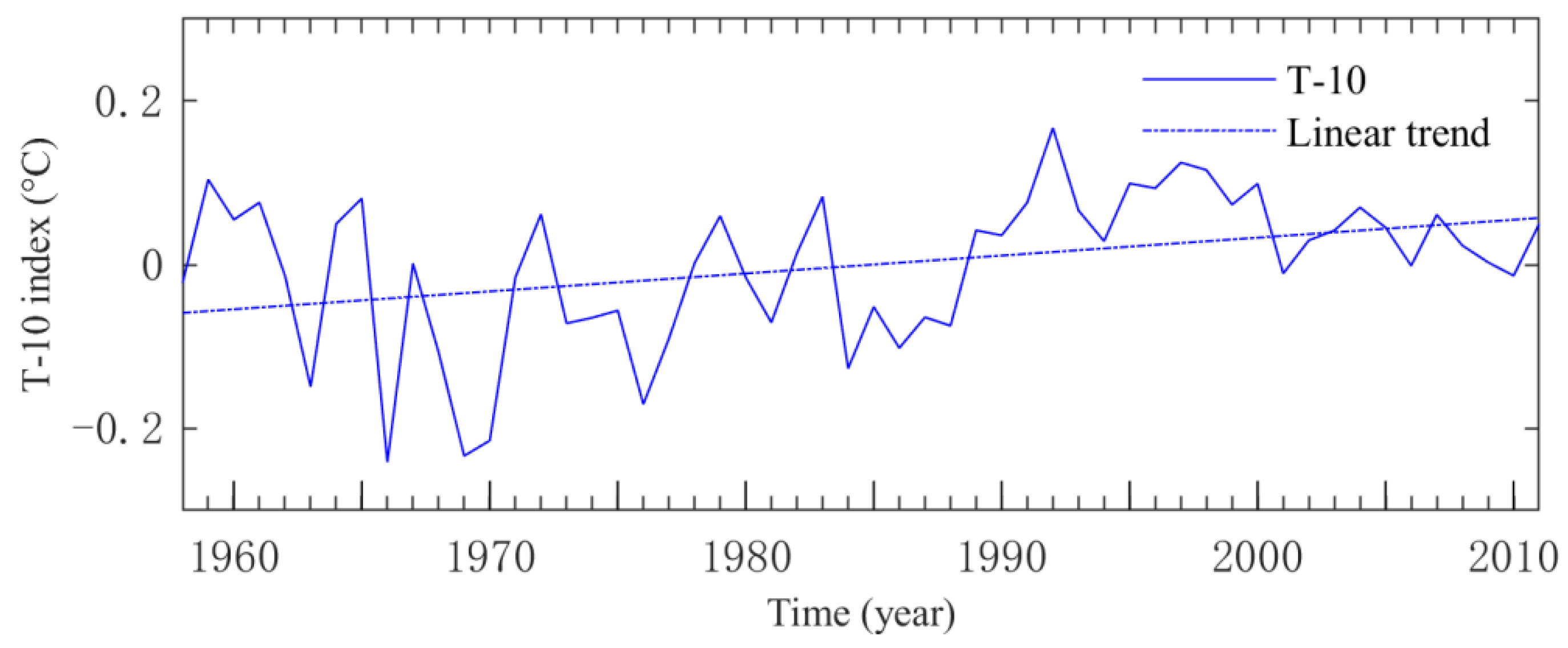
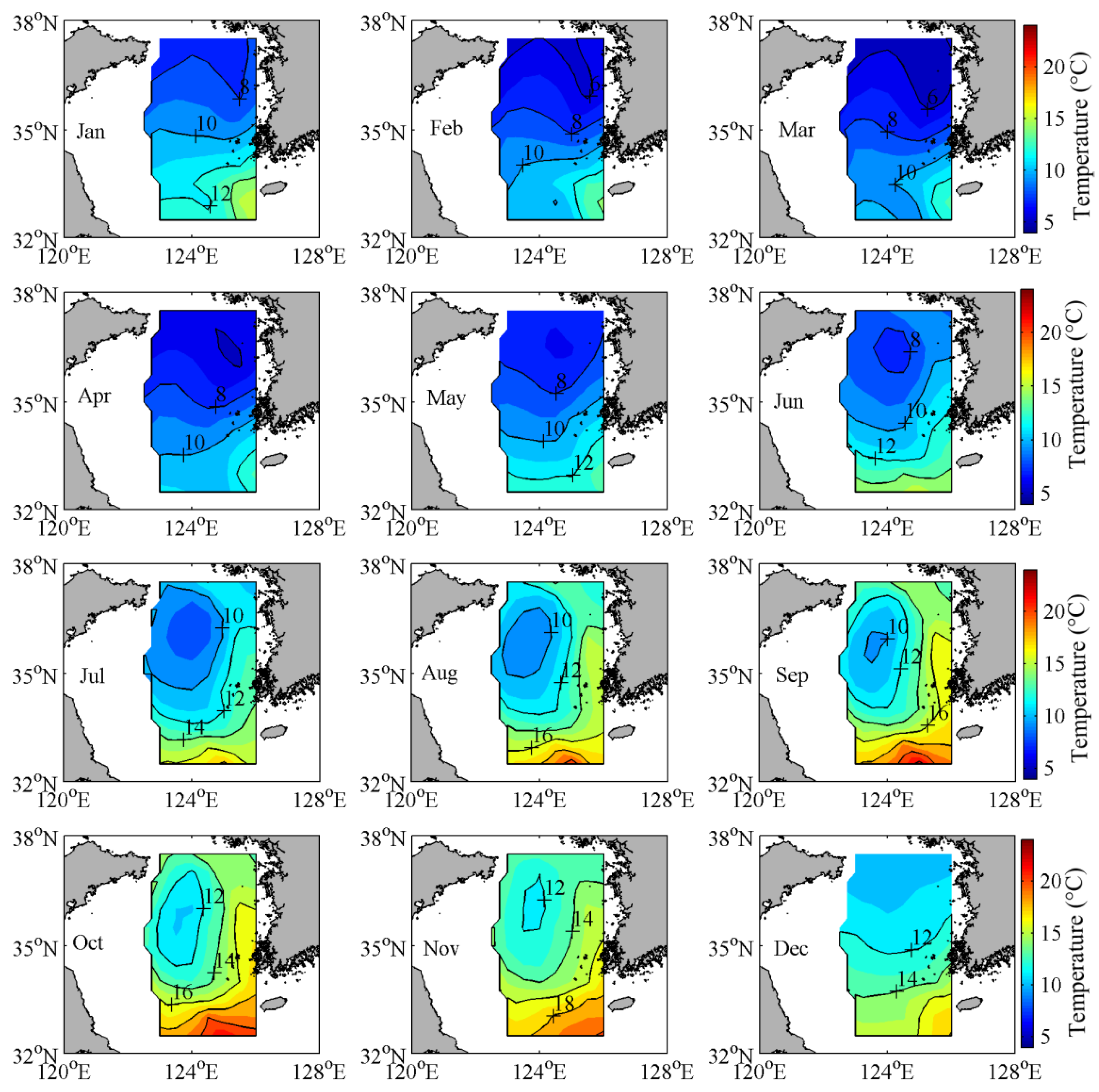

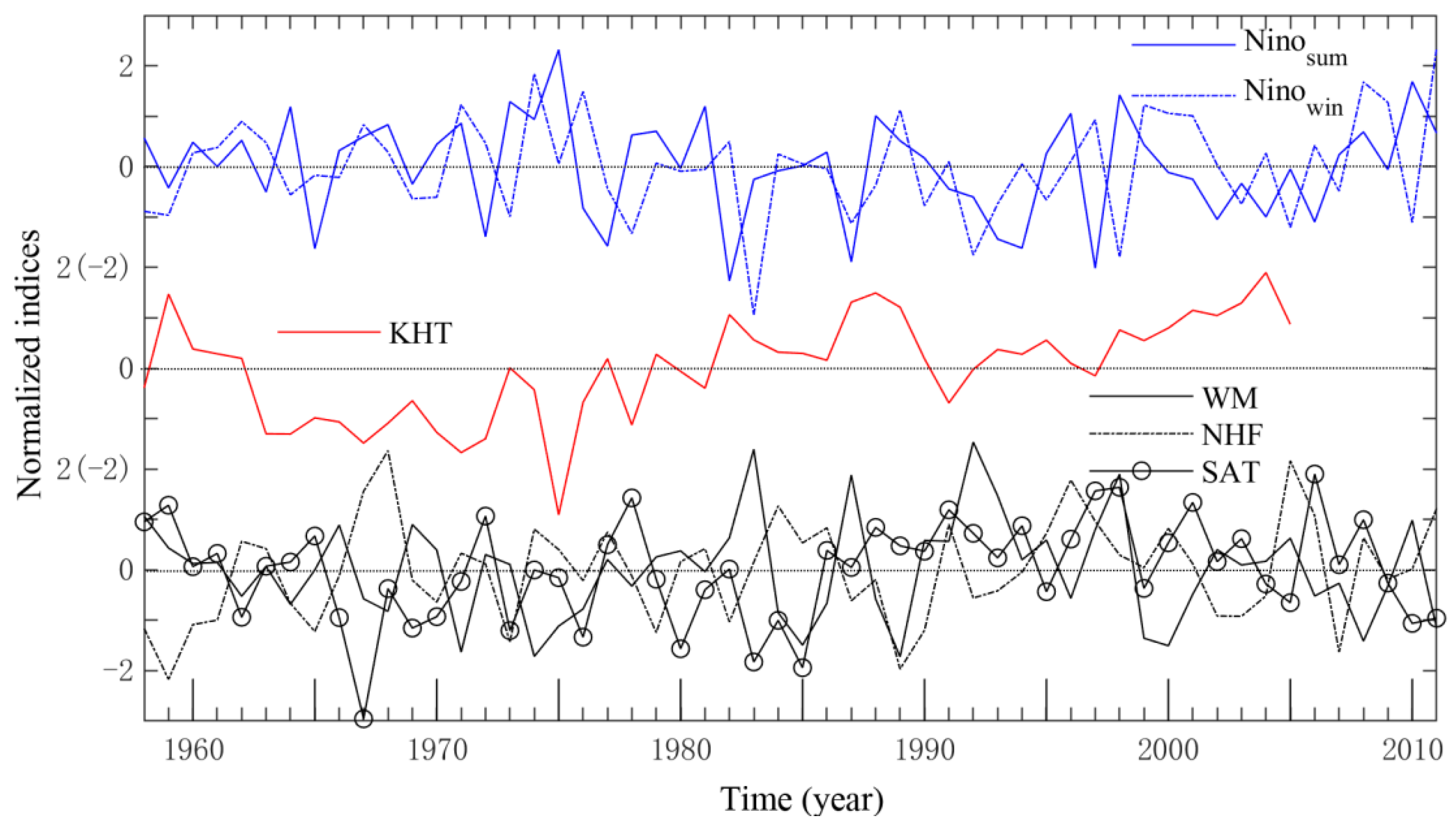
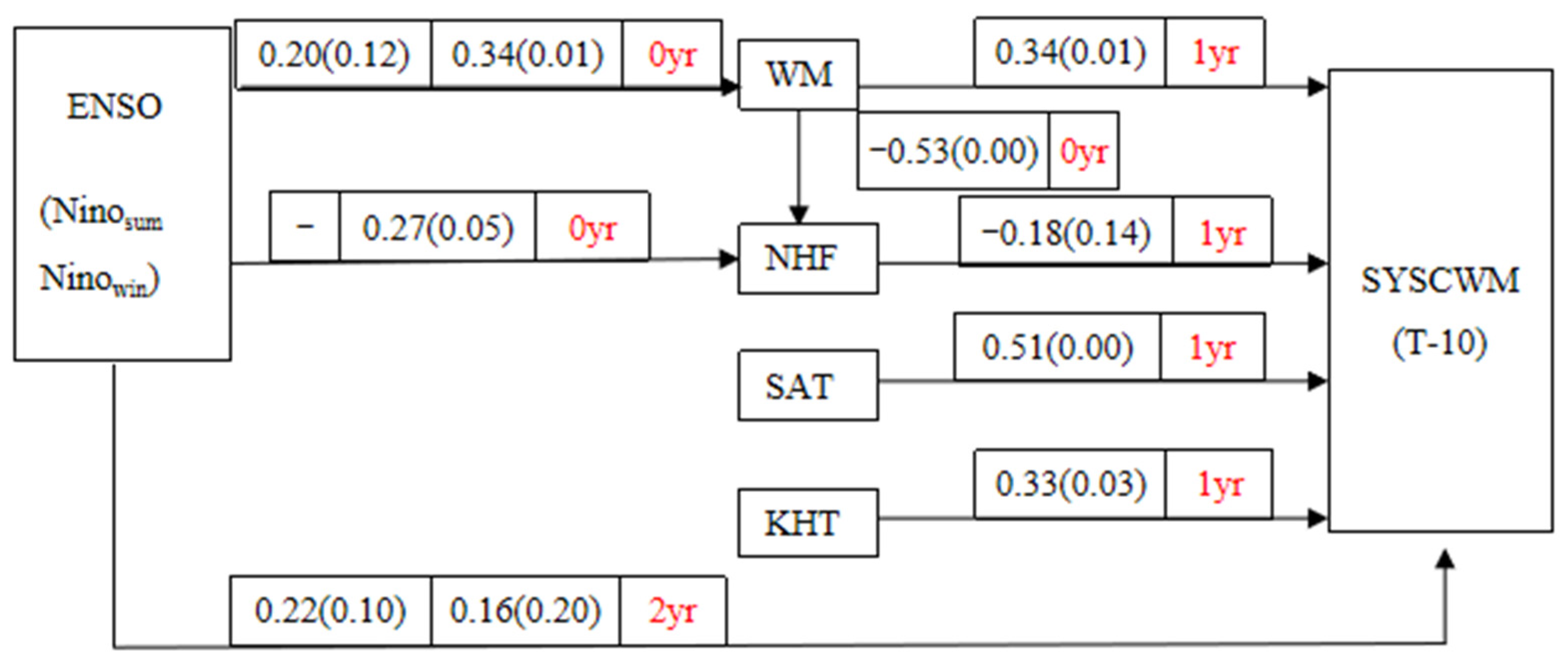
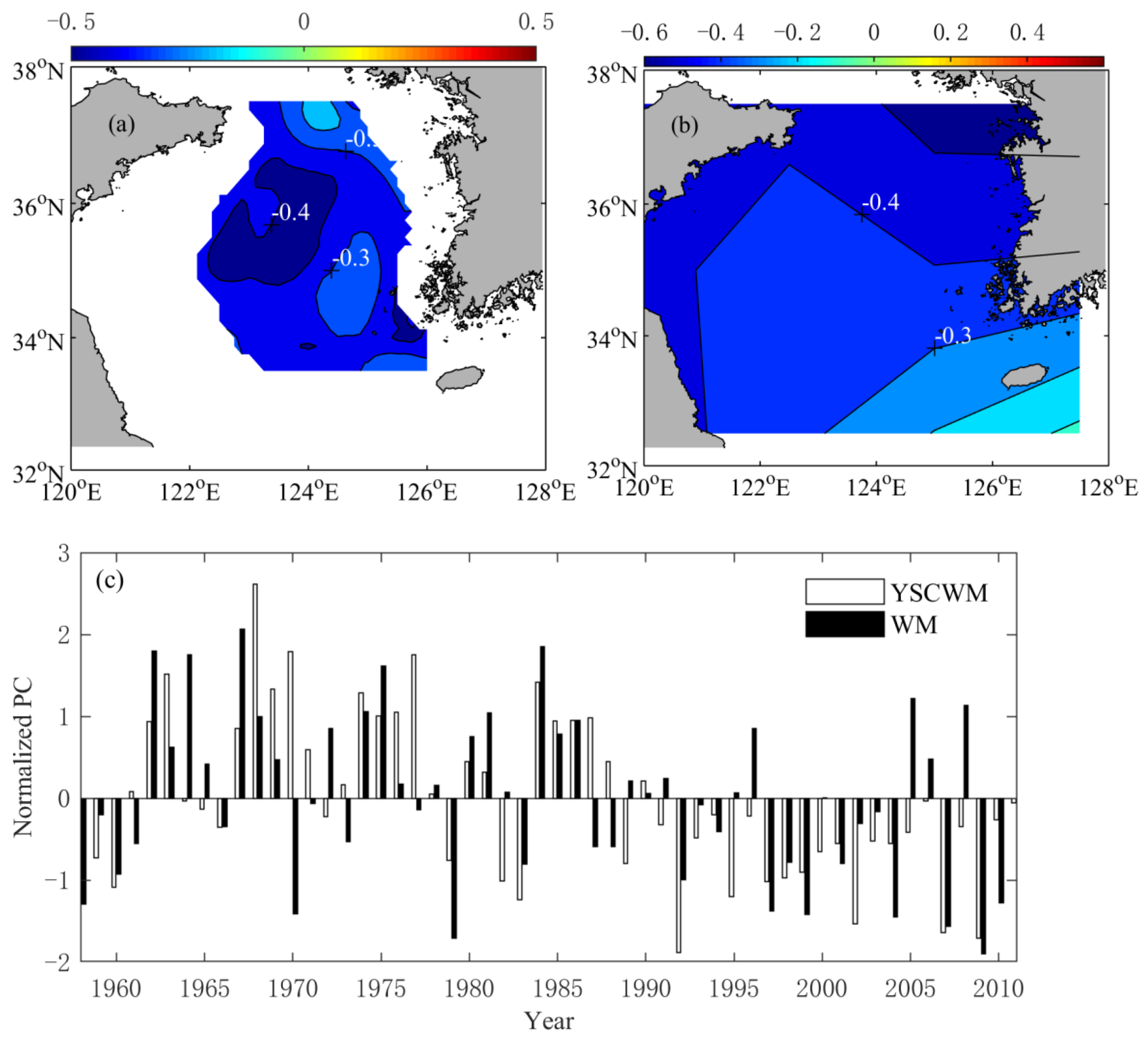

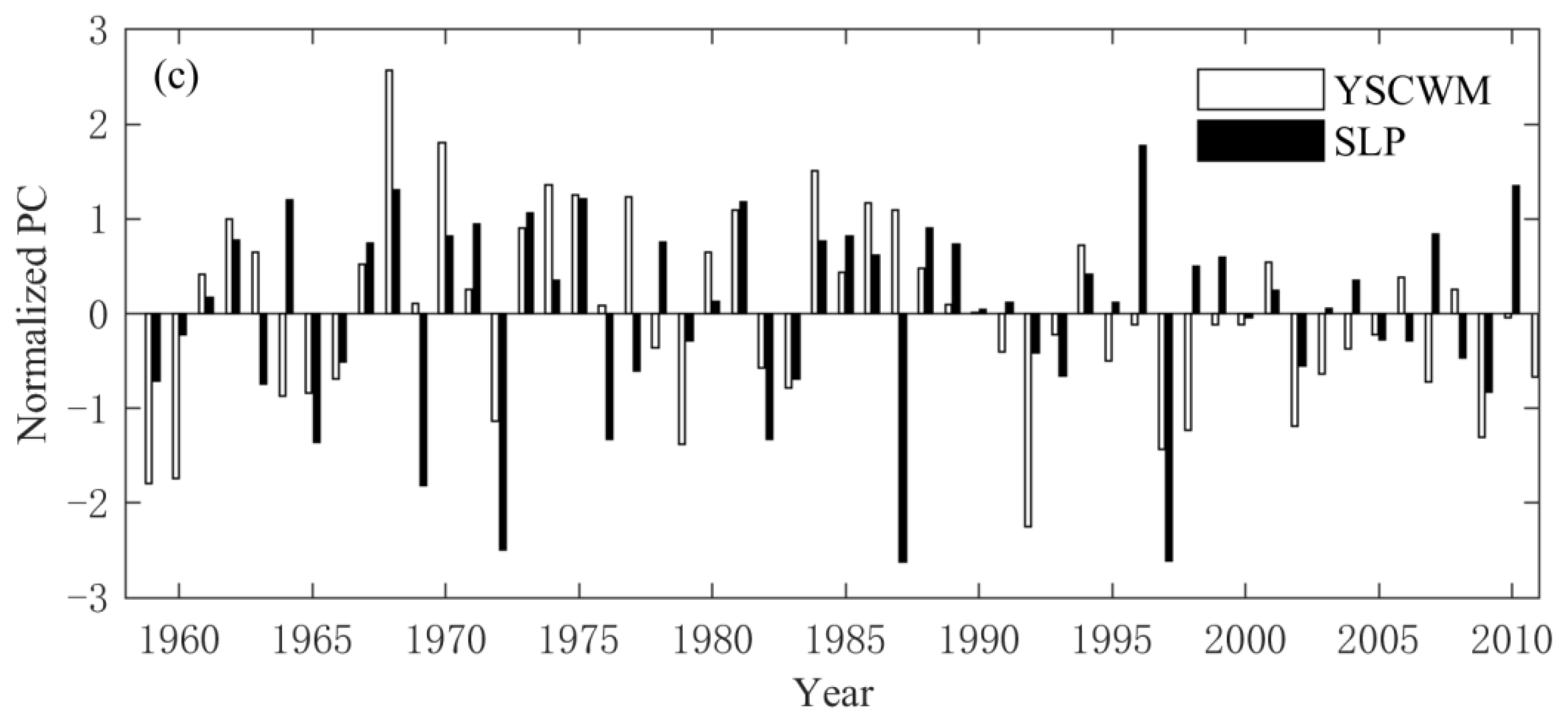
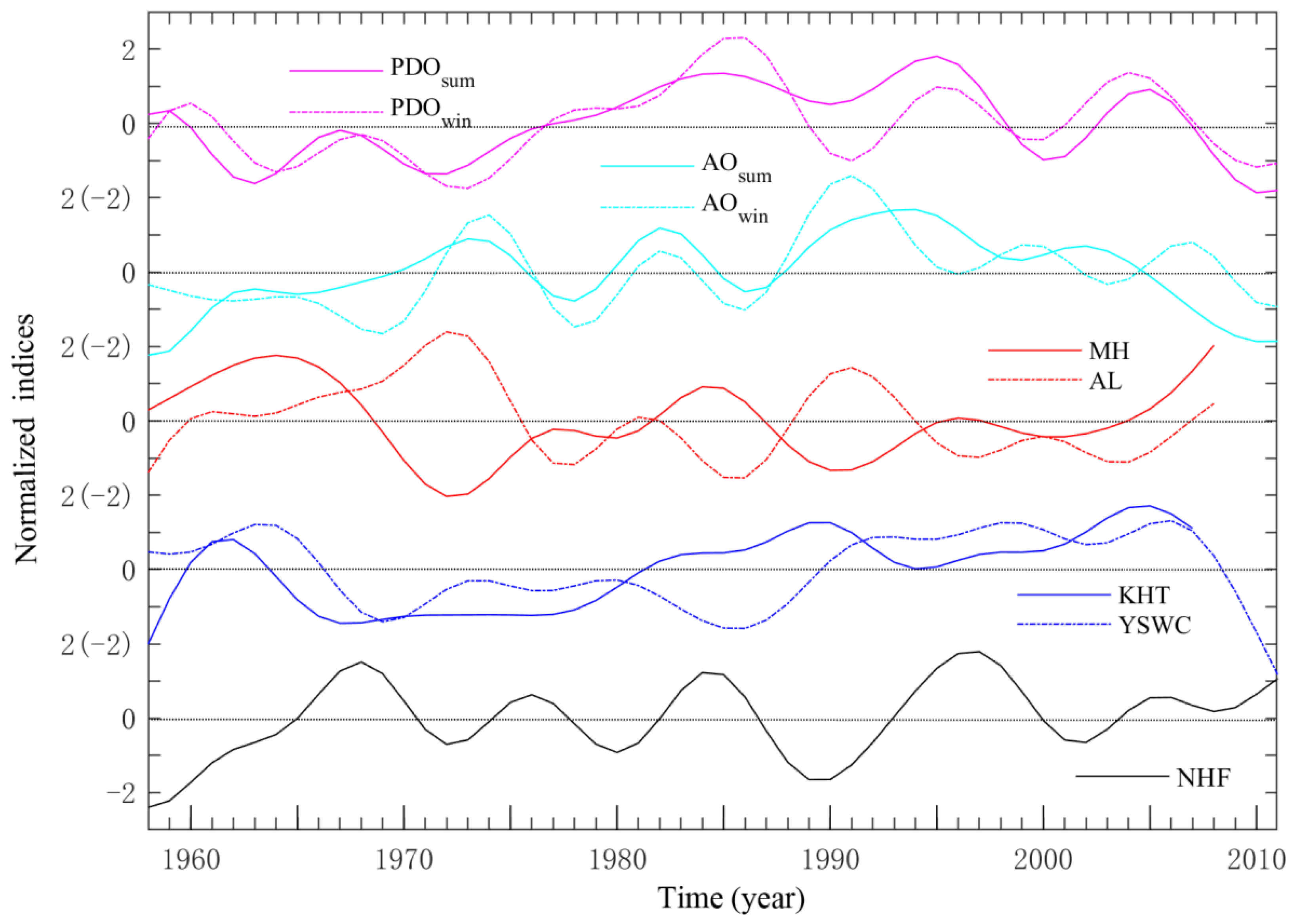
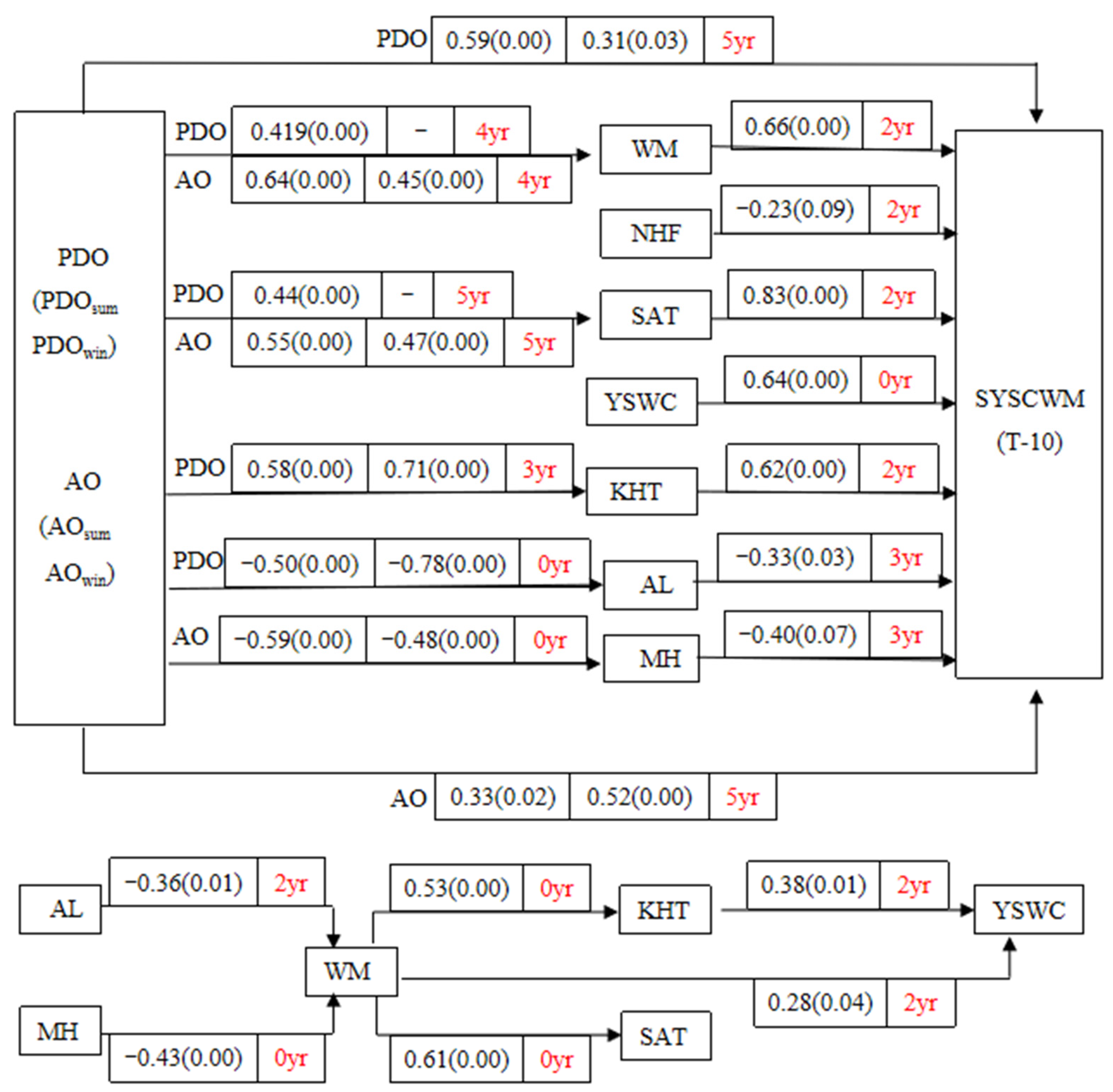
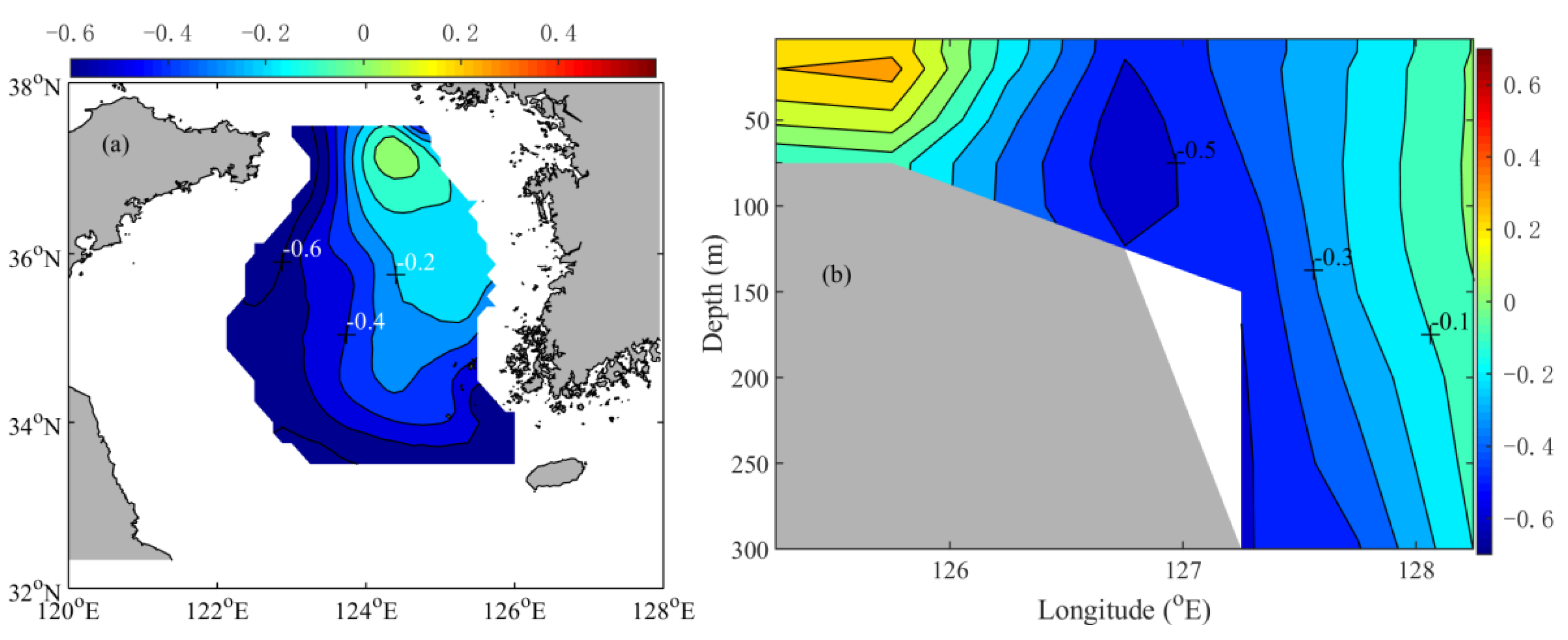

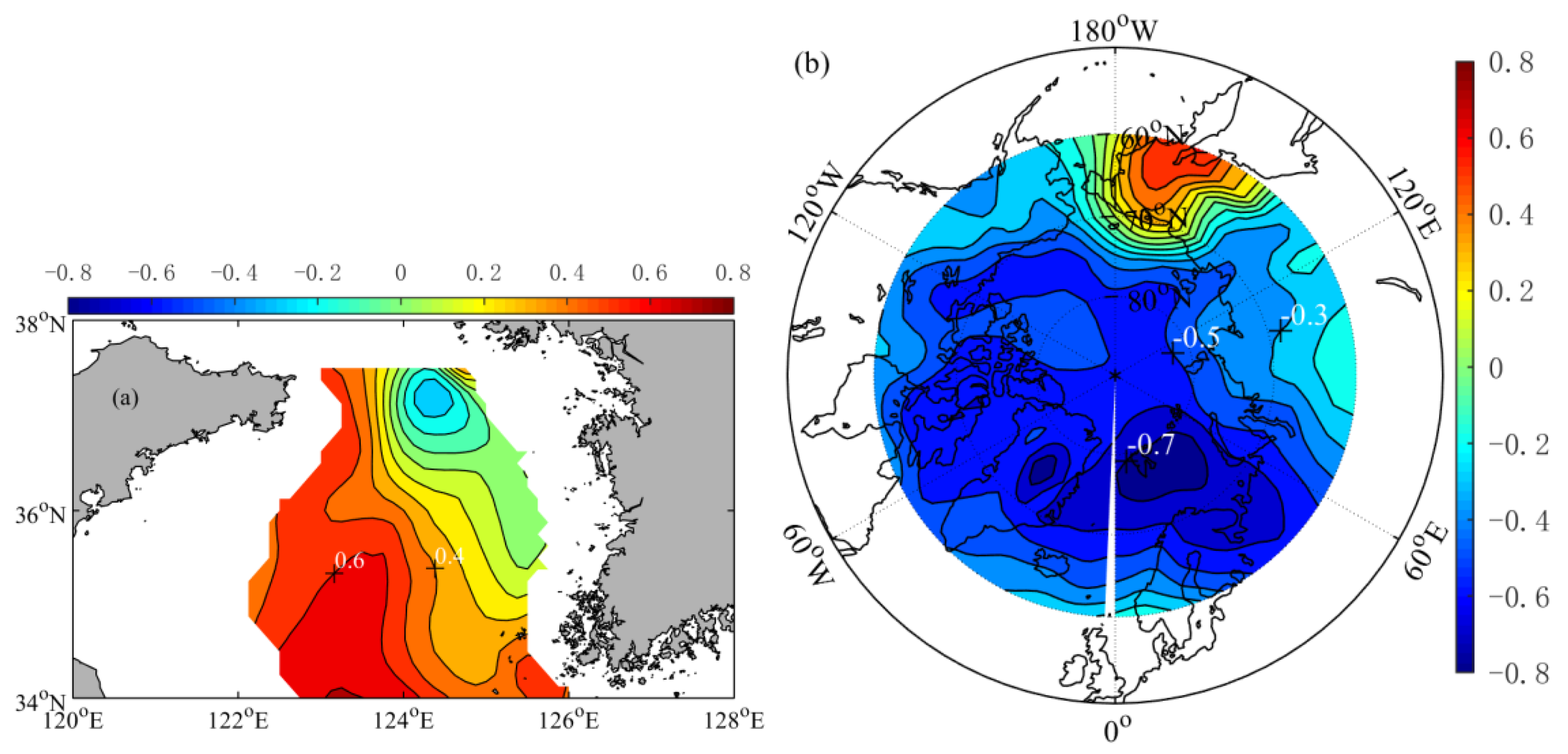



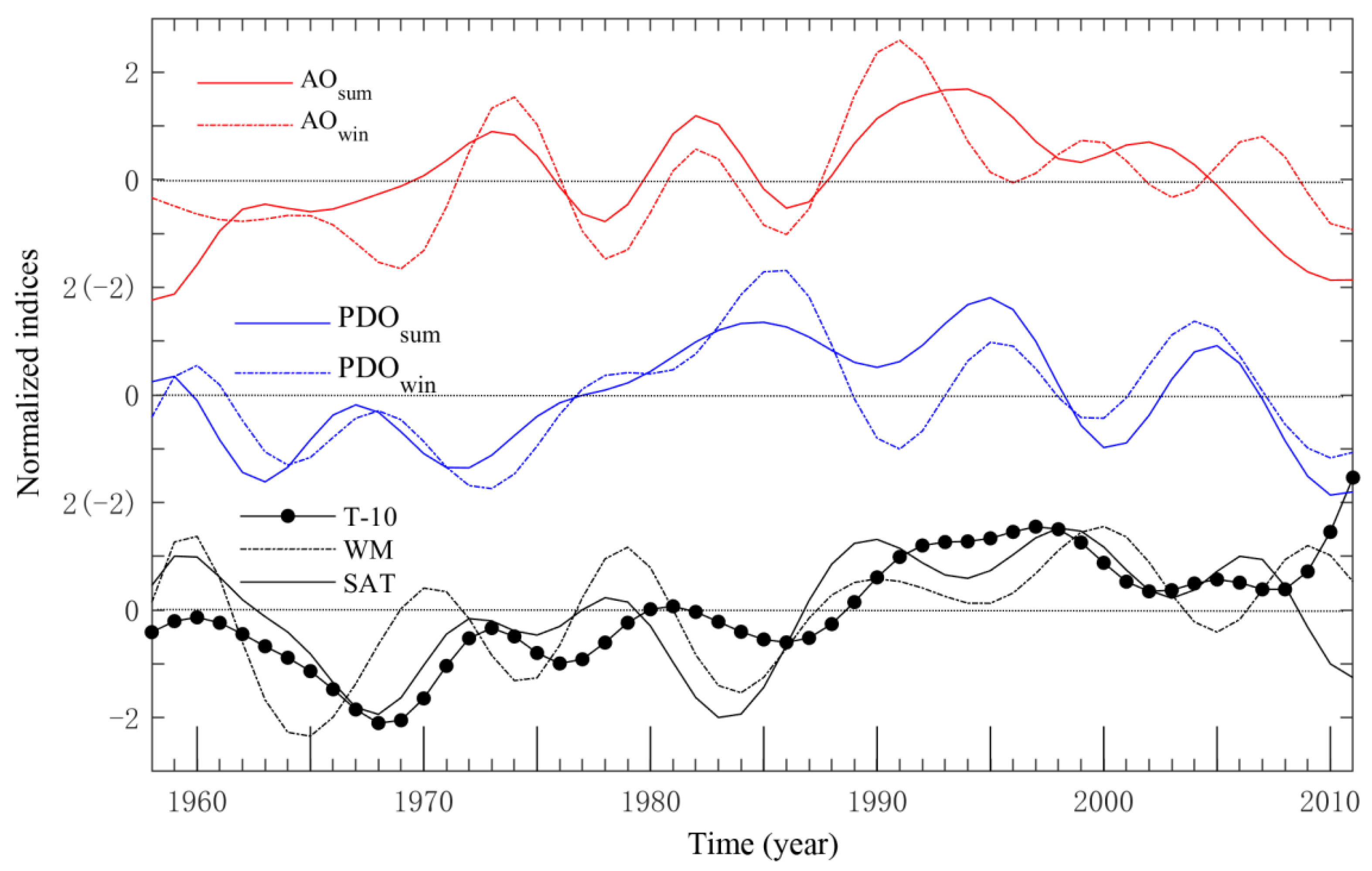
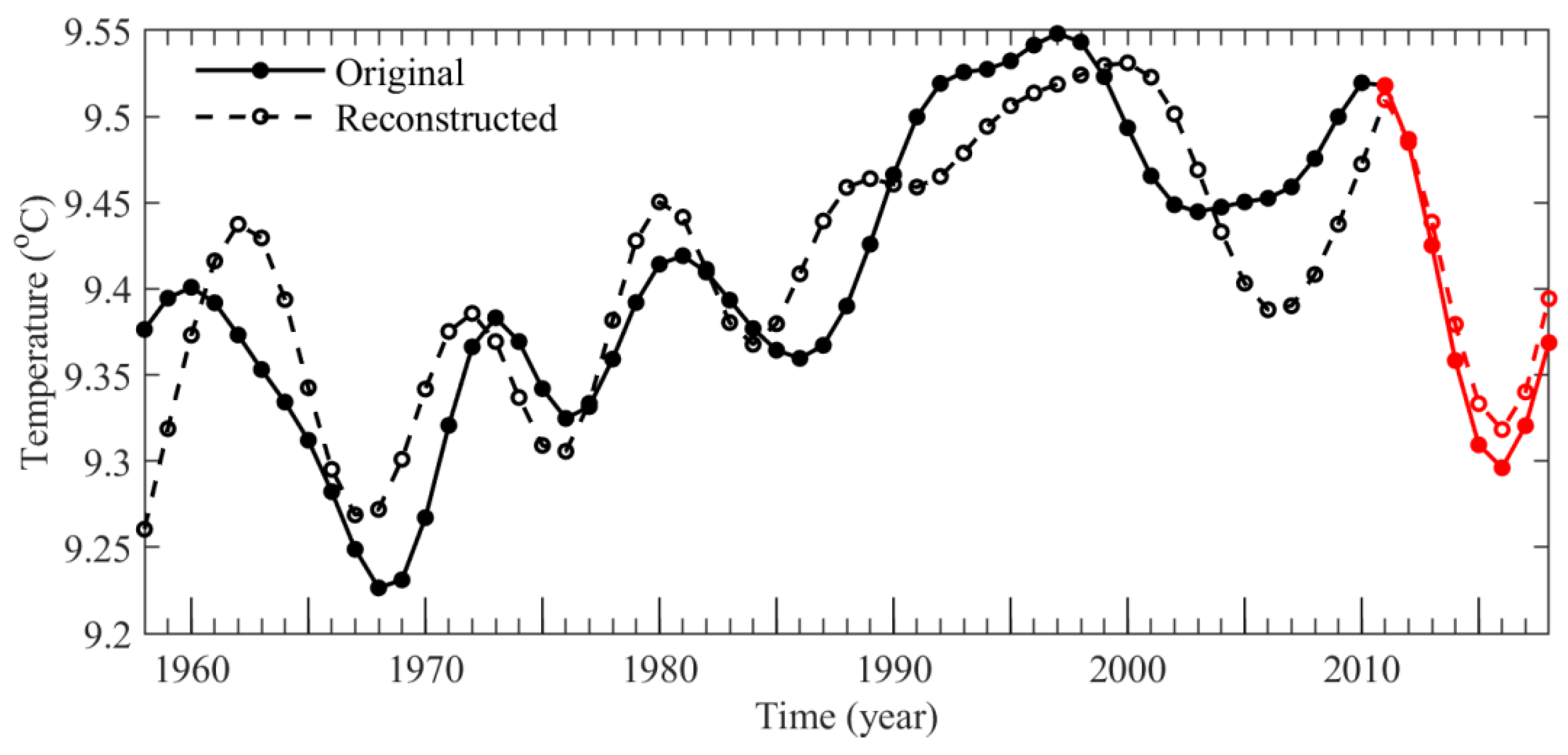
| Fraction of Covariance (%) | Correlation Coefficient of Time-Series | |
|---|---|---|
| WM−SYSCWM | 92 | 0.48 |
| NHF-SYSCWM | 89 | 0.56 |
| SAT-SYSCWM | 99 | 0.78 |
| ENSOsum-WM | 79 | 0.50 |
| ENSOsum-SYSCWM | 68 | 0.38 |
| ENSOwin-NHF | 84 | 0.43 |
| WM−NHF | 93 | 0.62 |
| Fraction of Covariance (%) | Correlation Coefficient of Time-Series | |
|---|---|---|
| MH-SYSCWM | 51 | 0.67 |
| MH-WM | 84 | 0.52 |
| AL-SYSCWM | 88 | 0.49 |
| AL-WM | 51 | 0.47 |
| KHT- SYSCWM | 90 | 0.61 |
| PDOwin-SYSCWM | 85 | 0.76 |
| PDOsum-WM | 70 | 0.50 |
| PDOsum-SAT | 88 | 0.49 |
| PDOwin-AL | 65 | 0.72 |
| PDOwin-KHT | 54 | 0.46 |
| AOwin-SYSCWM | 92 | 0.65 |
| AOwin-WM | 87 | 0.35 |
| AOwin-SAT | 95 | 0.52 |
| WM−SAT | 96 | 0.57 |
| WM−KHT | 84 | 0.39 |
Publisher’s Note: MDPI stays neutral with regard to jurisdictional claims in published maps and institutional affiliations. |
© 2021 by the authors. Licensee MDPI, Basel, Switzerland. This article is an open access article distributed under the terms and conditions of the Creative Commons Attribution (CC BY) license (https://creativecommons.org/licenses/by/4.0/).
Share and Cite
Guo, Y.; Mo, D.; Hou, Y. Interannual to Interdecadal Variability of the Southern Yellow Sea Cold Water Mass and Establishment of “Forcing Mechanism Bridge”. J. Mar. Sci. Eng. 2021, 9, 1316. https://doi.org/10.3390/jmse9121316
Guo Y, Mo D, Hou Y. Interannual to Interdecadal Variability of the Southern Yellow Sea Cold Water Mass and Establishment of “Forcing Mechanism Bridge”. Journal of Marine Science and Engineering. 2021; 9(12):1316. https://doi.org/10.3390/jmse9121316
Chicago/Turabian StyleGuo, Yunxia, Dongxue Mo, and Yijun Hou. 2021. "Interannual to Interdecadal Variability of the Southern Yellow Sea Cold Water Mass and Establishment of “Forcing Mechanism Bridge”" Journal of Marine Science and Engineering 9, no. 12: 1316. https://doi.org/10.3390/jmse9121316






